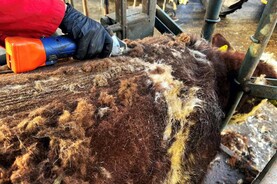Grazing stemmy covers
Grass growth rates have taken a hammering over the past few weeks, and while we have seen a slight recovery in growth in the past few days, some farms are still coming under pressure. PastureBase Ireland figures show an average farm cover of 618kg DM/ha, which would normally equate to a pre grazing yield of 1,250-1,300kg DM/ha.
However, from talking to farmers, farm covers consist of heavier, stemmy covers and covers that are extremely low and have failed to bounce back, with very little nice leafy covers available,
In normal circumstances, the advice would be to mow these covers and bale them. However, there is little sense in baling covers this week and possibly having to feed bales next week.
Strip wires should be utilised to maximise utilisation rates. Where spring born calves are present, the wire should be raised using a longer post to allow for creep grazing.
Topping is not generally recommended, as it can cause a slow down in recovery. If you are topping, ensure that the topper is set low enough (3.5-4.5cm) that it is correcting grass quality for the next round as opposed to improving the look of paddocks.
Pre-mowing is also an option, and often works best with a strip wire in beef stock, whereby one or two swards or a small area is mown and grazed in a day.
Fly control
While there haven’t been many incidents of summer mastitis this year owing to the cooler than average temperatures, warmer weather on the way could see a spike in fly numbers and associated health issues.
Maiden and in-calf heifers and dry cows are the most at risk of infection, though late calved spring calving cows with high milk yields are also prone to summer mastitis.
Pour-ons are likely the most effective control for flies, while farmers using garlic licks generally report low incidences of mastitis. However, these need to be in place several weeks before they become effective.
Stockholm tar can be applied to teats to create a barrier, though this will have to be repeated every few days and is labour intensive. Keeping cattle away from shaded areas where flies congregate will help ease fly burden on stock.
Scanning
Early bred cows can now be scanned to help identify if there are any underlying issues with breeding. Where breeding has been running for six weeks plus (two rounds) and there is still high activity levels being seen, scanning should take place promptly.
If a large number of cows are proving not in calf, the first port of call is either the bull or AI flask. Stock bulls should be semen tested and observed to ensure that they are capable of serving a cow.
Where AI has been used and cows are scanning empty, a test can be carried out on straws in an AI flask to ensure the semen is still alive in them, and that they have no been exposed to heat/poor handling.
If none of the above appear to be a problem, then the attention must turn to the cow. Scanning will identify if cows are not cycling and may need to be synchronised, as well as any ‘dirty’ cows that will have to be washed out.






 This is a subscriber-only article
This is a subscriber-only article










SHARING OPTIONS: